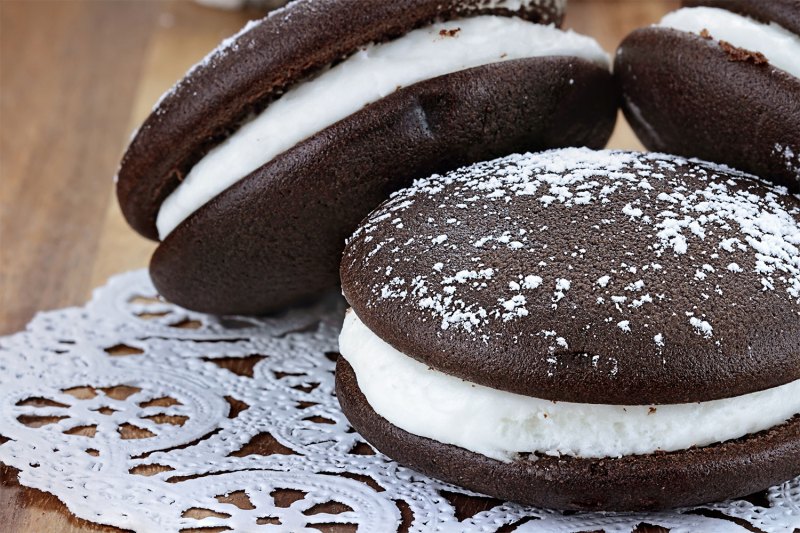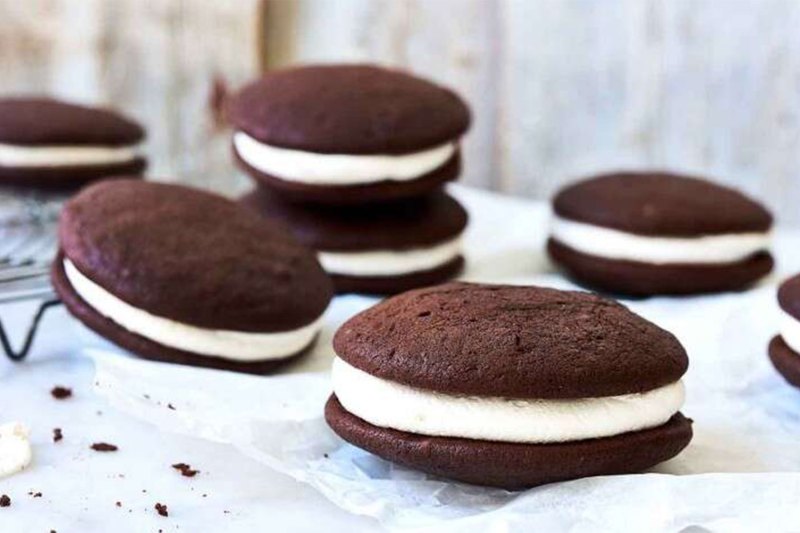Every region of the United States claims certain dishes and treats as its own, imbuing these food items with a strong sense of local identity. In some cases, it’s easy to agree that a certain dish belongs to a certain area of the country; no one’s trying to argue that Key lime pie originated anywhere but southern Florida, after all. But some culinary specialties have more than one part of the U.S. vying for credit, each area convinced that the dish in question started off in their neck of the woods. For a prime example of a hotly-contested regional bite, look no further than the whoopie pie.
What are “whoopie pies”?
Traditionally, a whoopie pie consists of two circular cakes (typically chocolate) bound together by a frosting filling. In the most commonly found versions of this dessert, the filling consists of marshmallow creme.

“Whoopie pies to me are essentially the Oreo’s lesser-known but superior cousin!” insists Chicago-based baker and food blogger Caitlin Conner of Plantwell. “They are soft and packed with the most delicious complementary flavors of rich dark chocolate and sweet vanilla. They deserve more popularity!”
“As a pastry chef, I love to make nostalgic treats that bring us joy – and I think that is exactly what whoopie pies do. They are not fancy and can be messy, but they always remind you of childhood joy. I think they deserve their time to shine as a dessert that anyone can make at home and enjoy a mini handheld cake!” says lead chef Tracy Wilk of the Institute of Culinary Education about whoopie pies.
Where can you find whoopie pies?
As a New Englander myself, I’ll admit that I will always and forever associate whoopie pies with northern New England…and, particularly, with the state of Maine. In fact, the Maine State Legislature designated the whoopie pie as its official State Treat in 2011. Mainers take enormous pride in their chocolate-cake-and-marshmallow sandwiches, and product manager Jennifer Mayne of Dorothy Lane Market in Dayton, Ohio tells us that “I grew up in Maine and have always loved whoopie pies. I live in Ohio now, so I need to make them myself if I want to indulge. I feel a connection to my roots when I make them and eat them. It’s fun to introduce people here in Ohio to this special treat. They all love it (and make fun of the name). It’s a great tradition to share with others.”
That said, some Pennsylvania natives (especially those based in or around Pennsylvania Dutch Country) believe that the whoopie pie was invented by the Pennsylvania Amish community, where it has been a popular purchase at roadside farm stands.
There’s no clear answer as to which area first introduced the whoopie pie to the culinary lexicon; but the fact that the debate still continues stands as a true testament to the whoopie pie’s popularity.
Whoopie pies are more customizable than you may expect.
In spite of the fact that traditional whoopie pies include chocolate cake and vanilla-marshmallow filling, there’s no need to strictly hew to those flavor guidelines. As long as you’re using two circular, soft-textured baked goods and a creme interior, then you’re still operating within whoopie pie bounds. As far as creative spins on the whoopie pie go, we’ve got two great examples right here:
Consider replacing the chocolate cakes with rounds of brown bread
At his St. Louis restaurant Bulrush, Chef Rob Connoley specializes in Ozark-inspired cuisine. For that reason, his take on whoopie pies consists of brown bread and a maple-marshmallow creme. “In our research of early 19th century Ozark cuisine, there were few recipes to be found – cornbread and pone, fruit cake, and brown bread. Each is simplistic in their ingredients and instructions, making them easy to remember and share through oral tradition. Brown bread is a clear connection from the settlers moving in from the northeast. Here, we update brown bread to be a fun whoopie pie with maple marshmallow fluff filling,” explains Connoley.
Gingerbread whoopie pies are ideal desserts for the holiday season
Baker, blogger, and recipe developer Krystle Smith of Baking Beauty has an undeniable soft spot for whoopie pies, telling us that “whoopie pies are pure comfort food to me. They remind me of childhood summers baking with my family. Bonus: The perfect cake-to-frosting ratio in every mouthful.” Her appreciation for the standard version inspired her to play around with different flavors and ingredients, leading to her holiday-appropriate Gingerbread Whoopie Pies.

Classic Chocolate Whoopie Pies
(By Martin Philip, baker, King Arthur Baking Company, Norwich, Vermont)
Only one state separates Vermont from Maine, so it stands to reason that Vermont-based bakers like Martin Philip of the King Arthur Baking Company would have a fondness for whoopie pies. “I was that kid that didn’t get packaged cupcakes or treats in my lunch box. Raised on the opposite end of the spectrum, I choked down honey-sweetened wholegrain briquettes and tried to smile through my lunchroom envy. But I’m making up for it now with homemade whoopies. The whoopie pie, or, as I think of it, ‘cake with a handle,’ is as versatile a treat as you’ll find. Whether dark chocolate with homemade marshmallow and meringue buttercream fluff filling or a fall version with pumpkin cake batter and cream cheese icing, this treat is good for all seasons. Our twist on this classic includes espresso powder for extra depth of flavor. And here’s a pro tip, in the summertime, you can eat these right out of the freezer like an ice cream sandwich,” Philip tells The Manual.
Ingredients:
For The Cakes:
- 8 tbsps butter, at room temperature
- 1 cup brown sugar, packed
- 1 tsp espresso powder (optional)
- 1 tsp baking powder
- .5 tsp baking soda
- .75 tsp salt
- 1 tsp vanilla extract
- 1 large egg, at room temperature
- .5 cup Dutch-process cocoa
- 2.33 cups all-purpose flour
- 1 cup milk, at room temperature
For The Filling:
- 1 cup vegetable shortening
- 1 cup confectioner’s sugar or glazing sugar
- 1.33 cups Marshmallow Fluff or marshmallow creme
- .25 tsp salt, dissolved in 1 tbsp water
- 1.5 tsps vanilla extract
Method:
- Preheat the oven to 350°F. Lightly grease (or line with parchment) two baking sheets.
- To make the cakes, beat together the butter, sugar, espresso powder, baking powder, baking soda, salt, and vanilla in a large mixing bowl until smooth. Add the egg, beating until smooth.
- Add the cocoa, stirring to combine.
- Add the flour to the batter alternately with the milk, beating until smooth. Scrape down the sides and bottom of the bowl, and beat again briefly to soften and combine any chunky scrapings.
- Drop the dough by the quarter-cupful onto the prepared baking sheets, leaving plenty of room between the cakes; they’ll spread. A muffin scoop works well here.
- Bake the cakes for 15 to 16 minutes, until they’re set and firm to the touch. Remove them from the oven, and cool on the pans. While still lukewarm, use a spatula to separate them from the pan or parchment; then allow to cool completely.
- To make the filling, beat together the shortening, sugar, and marshmallow until well combined.
- Dissolve the salt in the water and add to the marshmallow mixture. Add the vanilla, and beat until smooth.
- Spread the flat side of half the cakes with the filling. Top with the remaining cakes, flat side toward the filling. Wrap individually, in plastic wrap, until ready to serve.



